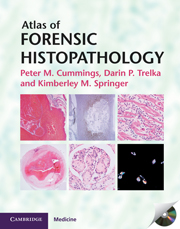8 - Pediatrics: special topics
Published online by Cambridge University Press: 05 August 2013
Summary
INTRODUCTION
There are few areas in forensic pathology that are as challenging as deaths involving children. It takes many years of experience to become comfortable with the histology associated with pediatric cases. The normal infant lung is more cellular than the adult and often it is atelectatic, giving the appearance of an inflammatory process. The kidney also is more cellular, and often sclerotic glomeruli are seen as part of the normal development process. These findings can sometimes be confusing. The issues surrounding potential child abuse cases are some of the most difficult we encounter. Trying to determine if an injury is inflicted or accidental is often a challenge and the literature is fraught with inconsistencies. There are also instances where the time of death becomes an issue, such as in fetal demise. This chapter touches on a few of these points and will serve as a guide for this murky, confusing area of forensic pathology. We draw our conclusions from recent publications and hope that the suggested reading section will aid the reader in making up his or her own mind. The autopsy in these cases is just a single piece of information. It must be interpreted in context with a thorough scene investigation, review of complete medical records, and review of all relevant investigative reports such as those written by police or child welfare investigators.
- Type
- Chapter
- Information
- Atlas of Forensic Histopathology , pp. 153 - 182Publisher: Cambridge University PressPrint publication year: 2000



